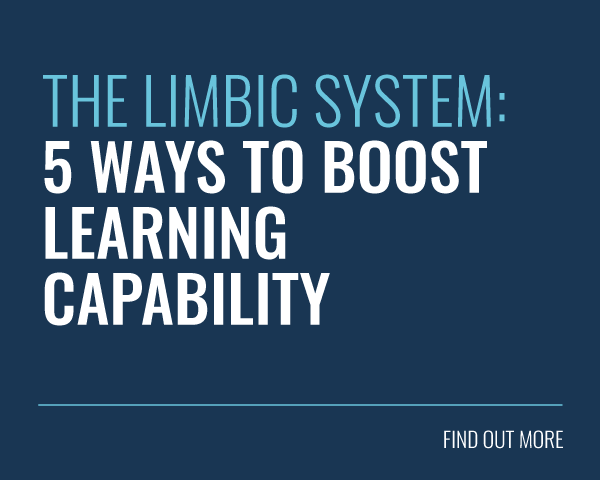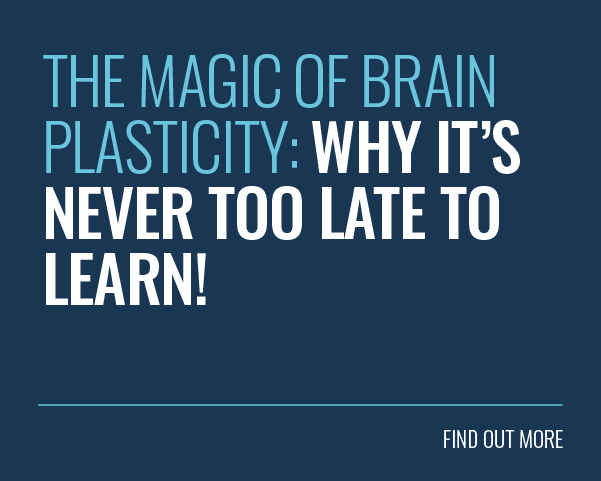
Tired of forgetting what you learn? You’re not alone. Spaced repetition is the answer you’ve been looking for. This evidence-based learning strategy will revolutionise the way you retain information, whether you’re a student or a working professional.
With this approach, you’ll be able to wave goodbye to all-night cramming sessions fueled by coffee and desperation. Instead, spaced repetition offers a steady drip of information that allows your brain to process, consolidate, and ultimately retain knowledge more effectively.
Whilst spaced repetition might initially appear more involved than cramming or rote memorisation, it’s surprisingly straightforward once you’ve got the hang of it. It’s even been used by Jeopardy! contestants to memorise over 200,000 questions. It’s also a fixture of popular apps like Duolingo, Memrise and Anki.
Your organisation can also benefit from spaced learning approaches. In the US alone, companies invested $101.8bn on training in 2023. We simply can’t afford to let these valuable training dollars go to waste due to knowledge decay.
In this article, we’ll uncover the secrets of this evidence-based approach to learning, exploring how and why it works, whilst delving into the research and establishing the optimal intervals for maximising learning efficiency.
Ready to revolutionise your learning?
What is Spaced Repetition?
Spaced repetition is a powerful learning technique backed by research and the principle of spaced learning.
This method involves reviewing information at progressively increasing intervals, which optimises its transfer from short-term to long-term memory. Think of it like a workout programme for your brain.
This contrasts with cramming, which focuses on short-term memorisation through intensive, massed learning in a limited timeframe. This often occurs immediately before an urgent deadline or exam. This approach has not been shown to be effective in the long-term.
Just as muscles weaken without consistent exercise, information fades from our memory without periodic review. Cramming, like a single intensive workout, provides a temporary boost, but it doesn’t lead to long-term retention.
Spaced repetition, on the other hand, is like regularly exercising your muscles. By reviewing information at increasing intervals, you gradually strengthen your memory and prevent it from fading over time.
The key to spaced repetition is to review information right before you’re about to forget it. This means frequent reviews initially, and gradually increasing the intervals as your memory strengthens.
As a result, you’ll be revisiting information at the optimal time to maximise retention, without wasting time on material you’ve already mastered. It’s a win-win for both learning efficiency and your long-term memory.
The Forgetting Curve
Our memory is fallible. As illustrated by the forgetting curve, information naturally fades from our short-term memories unless it is actively renewed.
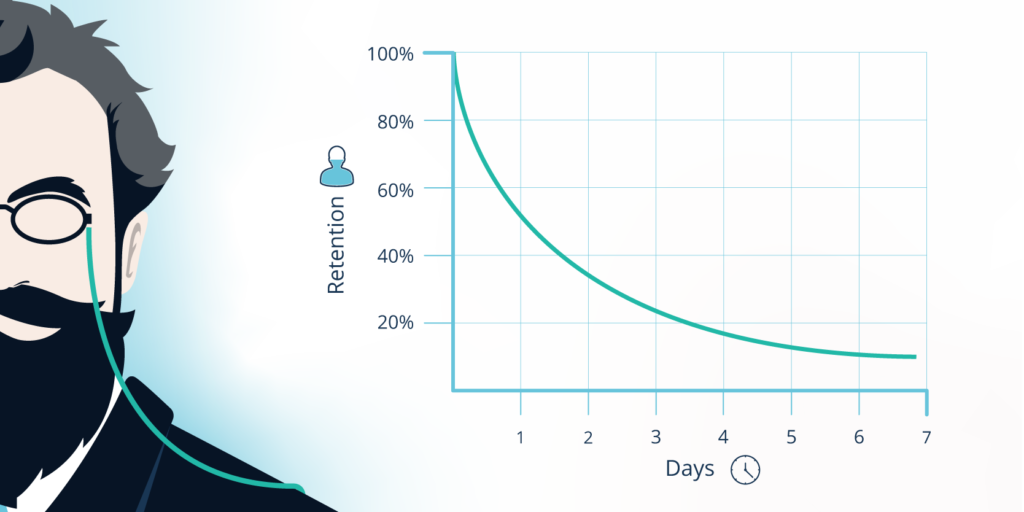
This memory model is attributed to German psychologist Hermann Ebbinghaus. In the 1880s, he conducted pioneering research by memorising nonsense syllables and testing his recall over time. He was able to show that we forget information at a remarkable rate:
- 50% of everything we learn within 1 hour.
- 70% of everything we learn within 24 hours.
- 90% of everything we learn within 1 week.
Thankfully, spaced repetition combats forgetting by strategically placing reviews right before you’re about to forget information. Repeating this process moves that information from your short-term memory over to your long-term memory.
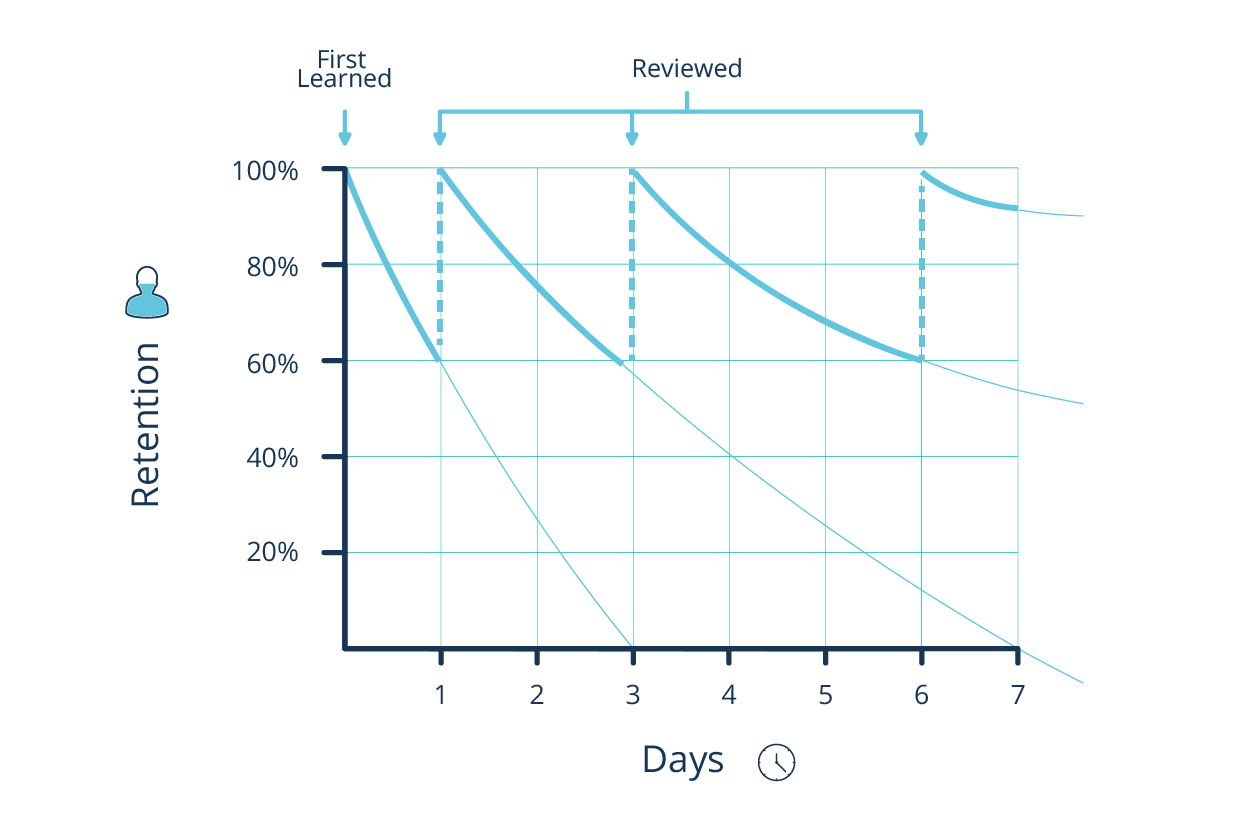
The graph above shows memory decay over time. The initial blue line shows the standard rate of decline. You can then see the impact that each spaced repetition has on knowledge retention.
This aligns with how our brains naturally learn. They need time to absorb, encode, and store information. By spacing out learning, we grant our brains crucial processing time and help to form connections between new and existing knowledge.
How Does Spaced Repetition Work?
Spaced repetition emphasises active recall rather than passive re-reading. After all, you need to actively retrieve information from your memory to ‘reset’ the forgetting curve. This typically involves getting hands-on, answering flashcards or completing quizzes.
Indeed, flashcards are a cornerstone of spaced learning, as you can adapt their display frequency to your learning progress. This means that newer and more challenging cards can appear more often, while familiar cards show up less frequently.
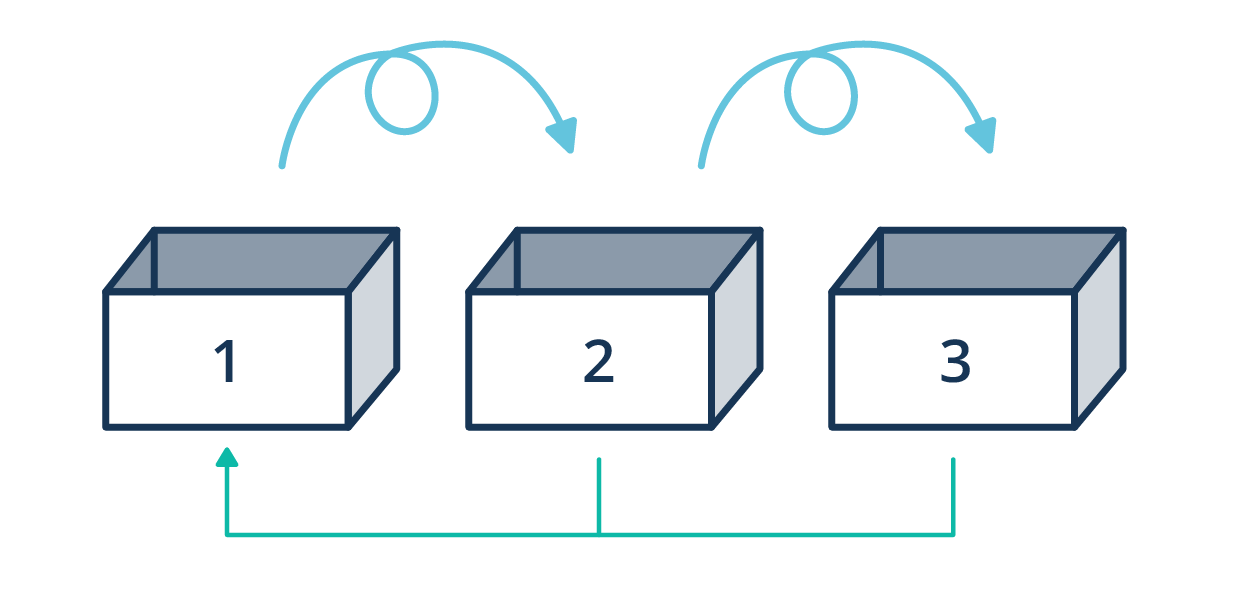
An example of this approach is the ‘Box Method’ (aka. the Leitner System). Here, you categorise flashcards into different boxes based on your recall difficulty. The cards you answer correctly move to a box with longer intervals between reviews. And those you struggle with move back to a box that you review more often.
According to author Gabriel Wyner, ‘Spaced repetition… [is] extraordinarily efficient. In a four-month period, practising for 30 minutes a day, you can expect to learn and retain 3,600 flashcards with 90 to 95 percent accuracy.’
What Intervals Should I Use?
As spaced repetition involves revisiting information at strategic times, a crucial question emerges: what are the most effective intervals between these reviews? Unfortunately, there’s no one-size-fits-all answer. Dang!
In fact, several factors influence optimal intervals, including:
- Your learning goals: If you have a deadline approaching, you might prefer shorter intervals. However, this will come at the expense of your long-term memory.
- Complexity: Challenging topics often benefit from shorter intervals for easier initial recall. You can then expand the intervals once information starts getting ‘sticky’.
- Individual differences: We’re all different. For instance, some of us retain information better and may be able to adjust the intervals accordingly.
With that said, there’s enough research on this topic to propose some recommendations that typically work well. These often follow a geometric sequence, for instance:

- Day 0: Initial learning
- Day 1: First repetition
- Day 6: Second repetition
- Day 14: Third repetition
- Day 30: Fourth repetition
- Day 66: Fifth repetition
- Day 150: Sixth repetition
- Day 360: Seventh repetition
In this case, after the second repetition, the previous interval is multiplied by 2.2 to create the following interval. According to Traverse.link, seven repetitions is usually sufficient to memorise information for life.
The key is to find an approach that works for you. We recommend starting with shorter intervals and gradually increasing them. Don’t be afraid to change your schedule based on your experience and the complexity of the material.
If you can’t get the balance right, then don’t worry. There’s spaced repetition software and apps that can help. These tools use algorithms that analyse performance and adjust review intervals accordingly. This makes your life easier by removing the guesswork.
Spaced Repetition: The Research
There are numerous studies demonstrating the effectiveness of spaced repetition. For a start, Ebbinghaus (the mastermind behind the forgetting curve) was able to show that spaced repetition significantly improves knowledge retention.
Furthermore, a 2006 meta-analysis of 317 studies on the spacing effect conclusively demonstrated the superiority of spaced repetition over cramming for long-term retention.
More recently, in 2020, a group of researchers from the University of Leicester used a custom-built app to collect data on the effects of different learning techniques. They were able to show that:
- Learners who used spaced repetition had an adjusted mean exam score of 70%.
- Learners who used massed learning (cramming) had an adjusted mean exam score of 64%.
- And learners who did not use the app at all had an adjusted mean exam score of 61%.
Finally, a 2022 meta-analysis in Nature Reviews Psychology, found that ‘spacing and retrieval practice… enhance learning in various domains across the lifespan’. Clearly there’s a big case for spaced repetition. So, what’s hindered its wider adoption?
Why is Spaced Repetition Not More Popular?
While spaced repetition boasts a strong evidence base for its effectiveness, it’s true that it’s not universally popular. Indeed, according to this 2011 report, students both prefer cramming and incorrectly believe that it’s more effective. There’s a few different reasons for this:
- Lack of Awareness: Many of us are simply unaware that spaced repetition is a viable option. Think about how you learned in school and education settings. Apart from exams, did you ever go back and revisit important topics and concepts?
- Time Investment: For many, spacing out learning feels like a bigger time investment than cramming it all into a single night’s work. Using a schedule feels daunting, even if the total study time ends up being similar.
- Perceived Difficulty: Cramming is rather elegant in its simplicity. Gather your materials and power through them in one sitting. Spaced repetition, on the other hand, requires setting up a schedule, creating flashcards and staying consistent.
The truth is, we’re all busy people. It’s difficult to find time to dedicate to learning. Indeed, according to Josh Bersin, workers only have 24-minutes to dedicate to formal learning each week. This makes spaced learning approaches particularly imposing.
However, we now know that cramming creates something of a false economy. Conversely, each spaced learning experience is an investment that unlocks numerous benefits. We’ll explore these advantages next.
Spaced Repetition: The Benefits

Spaced repetition offers a variety of different benefits for learners, helping to contribute to a more efficient and effective learning experience. These include:
- Enhanced Retention: As we’ve seen, spaced repetition does a great job of combatting the forgetting curve. As a result, it strengthens your memory and your ability to recall information when you need it.
- Deeper Understanding: Unlike passive learning methods (hello, re-reading and highlighting!), spaced repetition demands active engagement. This typically promotes a deeper level of understanding of the material at hand.
- Increased Efficiency: Spaced repetition focuses on revisiting information right before you’re about to forget it. As such, you’re focusing your attention where it’s needed the most, helping to reduce wasted energy and inefficiency.
- Improved Confidence: Just imagine the impact that improved knowledge retention would have on your confidence. You’ll be ready to take on new opportunities and embrace challenges with a clear and informed mind.
- Better Performance: Actively engaging with material and making connections between concepts equips you to apply your knowledge and skills within different contexts. As a result, you’ll build a strong foundation for future success.
Implementing Spaced Repetition Within Your Organisation
We’ve seen that spaced repetition works on an individual basis. But it also works at scale. Integrating spaced repetition into your learning and development strategies empowers employees to retain the knowledge and skills they need, leading to lasting impact.
According to researcher Sean Kang, ‘spaced practice is a feasible and cost-effective way to improve effectiveness and efficiency of learning, and has tremendous potential to improve educational outcomes.’
With this in mind, here are our six top tips for implementing spaced learning within a structured workplace learning programme.
- Campaign Learning: We know learning is not a one-time event. As such, you should seek to deliver training over time. You can do this by creating a learning campaign. For instance, you could start with an overview, then your content, follow-up with additional resources and wrap things up with an assessment.
- Microlearning: Craft an engaging learning journey by breaking complex topics down into bite-sized modules. This will make it easier for learners to revisit your training in the future and enhance their knowledge. It will also help you to slot your modules into your learning campaign structure.
- Learning Management Systems: Platforms like learning management systems (LMSs) or learning apps can be used to automate the spaced delivery of learning materials. This can often be achieved by using Levels or Curricula functionality. Don’t forget to use reporting tools to optimise your schedule as necessary.
- Gamification: These learning platforms often enable you to use gamification elements like experience points, badges and leaderboards. This empowers you to enhance your learner engagement levels whilst encouraging your audience to review information on a regular basis.
- Encourage Your Learners: As we’ve seen, many of us aren’t aware of the benefits of spaced repetition. With this in mind, consider providing your employees with resources and training on spaced repetition techniques. You should also encourage your learners to set up personalised review schedules.
- Mentor Programmes: If you’ve got a mentorship programme in place, then ensure your mentors are trained on spaced repetition principles. You can then schedule regular check-ins in line with your ideal spacing schedule. This will enable both the mentor and the mentee to revisit key learning points.
As with any good organisational learning initiative, you’ll need to tailor your implementation plan to your learners’ needs. You’ll then need to gather feedback from your audience and make adjustments to your approach as necessary.
Final Words
Spaced repetition works because it aligns with how our brains work. Just like batteries lose their charge over time, we lose our ability to retain information without reinforcement. Thankfully, spaced repetition acts like a smart charger for our brain.
It delivers information in manageable bursts at strategic intervals. As a result, our beleaguered brains have the time they need to process, consolidate and ultimately lock-in that knowledge for the long-haul.
The benefits for individuals and organisations are clear. Better knowledge retention leads to increased confidence, productivity and performance. In other words, you’ll be well primed to make a serious impact.
So, say goodbye to cramming. Embrace a learning technique that works smarter, not harder. And feel free to set a reminder to revisit this article later. You can consider it your first spaced repetition practice session!
Ready to dive deeper into the world of learning? Subscribe to our mailing list for more insights, or download our comprehensive ‘Guide to Learning Theories and Models’ to take your learning journey to the next level.




